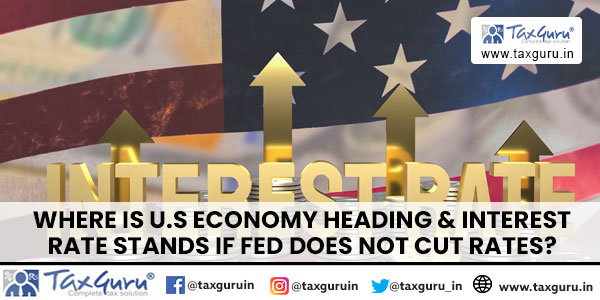The highly anticipated June Federal Reserve meeting has arrived, drawing intense scrutiny for insights into the Fed’s future moves. The more the U.S. Fed delays reducing interest rates, the more problems it will encounter, along with other economies. It’s clear that its own data is also questionable, creating further issues for the correct assessment of interest rate cuts. There is more noise in the market now after the EU cut its interest rates. Will the Fed cut rates, and if not, what are the consequences for the U.S. economy?
Concerns loom over the possibility of a recession in the US economy, underscored by several key indicators:
- Slowed GDP Growth: Q1 saw a sluggish 1.3% growth rate.
- Persistent Inflation: Inflation has held above 3% for 37 consecutive months.
- Mounting Deficits and Debt: A staggering $2 trillion deficit and a record-breaking $34.6 trillion national debt.
- Questionable Job Market Data: There are doubts about the accuracy of reported job figures, with suspicions that non-farm payrolls may have been overstated by as much as 730,000 jobs in 2023.
Of particular concern is the projection that, for the first time in history, annual interest payments on the national debt will surpass defense spending in 2024. The Congressional Budget Office (CBO) estimates interest spending to reach a staggering $900 billion for Fiscal Year 2024. In Q1 of the same year, interest costs reached an annualized $1 trillion, outstripping defense outlays by $29 billion. Moreover, over the first seven months of FY 2024, interest payments exceeded spending on vital programs like Medicaid, Medicare, and Defense, totaling $514 billion. Alarmingly, in 2023, interest payments as a percentage of GDP hit levels not seen in 25 years, even surpassing those witnessed during World War II. The urgent need for lower interest rates is palpable.
The surge in national debt is alarming. Since February 2019, the debt has skyrocketed by $12.5 trillion, while GDP has only increased by $7.2 trillion over the same period. This translates to a concerning ratio: for every unit of GDP growth, the government has accrued 1.7 units of debt. Such a debt-driven economy is unprecedented.
Bond markets paint a concerning picture as well. The US Treasury yield curve has been inverted for a record 702 days, with the spread between 10-year and 2-year Treasuries turning negative over 22 months ago. Historical precedence suggests that each time the yield curve has inverted, a recession has followed. Meanwhile, the Fed has begun tapering its balance sheet reduction (Quantitative Tightening), reducing it from $95 billion to $60 billion per month at the start of June.

Despite the unemployment rate holding below 4% for an impressive 27 consecutive months, recent data raises doubts. A record-breaking number of Americans are resorting to multiple jobs to make ends meet, indicative of underlying economic strain. The apparent strength in the job market may be illusory, as evidenced by a significant drop of 192,000 jobs in Q3 2023, a phenomenon typically associated with recessions.
The cost of servicing the national debt is soaring as older debt matures and is refinanced at higher rates. With nearly $35 trillion in debt and interest rates at 5%, projected interest payments for 2025 are a staggering $1.5 trillion, comprising nearly 30% of projected government revenue. The average interest rate on the national debt stands at 3.2%, the highest since 2010, with $5.9 trillion in Treasury Bills alone, bearing an average interest rate of 5.4%. Additionally, a record $9.3 trillion of national debt is set to mature within the next year, necessitating refinancing at potentially higher rates.
Since 2020, US consumers have significantly increased their debt burden, adding a staggering $3.4 trillion to reach a historic high of $17.7 trillion. Notably, credit card debt has surged by approximately $400 billion during this period, reaching an unprecedented $1.3 trillion in Q1 2024. This rapid accumulation of debt is occurring at a pace twice as fast as the buildup to the 2008 Financial Crisis. Compounding the issue, interest rates on this debt have skyrocketed from 16% to around 23%, marking a record high and exacerbating the rise in delinquencies.
The national debt, currently standing at $35 trillion, is largely short-term in nature, requiring refinancing within 12 months at rates of 5% or higher. A substantial portion of the debt, previously held at rates below 2%, is now being refinanced at over 5%, resulting in annual interest payments totaling $1.1 trillion. Alarmingly, a record $9.3 trillion of US federal debt is set to mature and necessitate refinancing at significantly higher rates over the next year. This represents a staggering increase of $4.7 trillion, or 102%, in just four years.
Adding to the complexity of the situation, the US Treasury has shifted towards issuing shorter-dated maturity bonds with lower interest rates. Consequently, approximately 33% of outstanding debt now has a maturity of less than a year. Meanwhile, the Federal Reserve has offloaded around $1.3 trillion of Treasuries from its balance sheet over the past two years through Quantitative Tightening (QT). Concurrently, foreign government demand for US bonds has waned, posing further challenges to the debt refinancing landscape.
In conclusion, the US economy faces mounting challenges, with indicators pointing towards economic fragility. Urgent action, including potential rate cuts, is imperative to steer the economy away from a looming recession. As U.S. elections approach, the rate cut is also a political point of debate. It’s high time before the currency war deepens that the U.S. must cut interest rates.






Good Insight